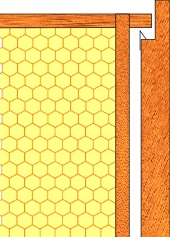Smith
The Smith hive was designed by W. Smith of Innerleithen near Peebles, Scotland. The design concepts were simplicity, adequate brood area for local conditions and ease of transport to the heather.
A brood chamber containing 11 National brood frames 14” wide x 8½” deep proved sufficient for the local bees but to design a hive of simple construction Smith followed the American Langstroth pattern.
| HIVE DATA | NATIONAL | NATIONAL 14×12 | SMITH |
|---|---|---|---|
| Brood frame | 14″ x 8½” | 14″ x 12″ | 14″ x 8½” |
| Super frame | 14″ x 5½” | 14″ x 5½” | 14″ x 5½” |
| Frames / brood box | 11 | 11 | 11 |
| Cells / brood box | 54,000 | 80,000 | 54,000 |
| Lug length | 1½” | 1½” | ⅜” |
The top bars of the National frames were reduced from 17” to 15½” and the resulting short lugs were let into a rebate cut into the thickness of the end wall.

Note the rebate cut into the thickness of the hive wall and the resulting short lugs. The original design was top bee space (as shown) but can be made bottom bee space if preferred.
The resulting hive is 18¼” x 16⅜” made from four pieces of timber. Compare this to the more complex Modified National which is 18⅛” square and requires eight pieces of timber.
The Smith hive is still popular today in the north of the country where the season is shorter, the weather cooler and the brood chamber sufficient for a normal colony. Further south the brood chamber may prove too small for a prolific colony so the beekeeper may expand the brood area using the same techniques as with the National, namely brood and a half, double brood or 14 x 12.
The single large size of 14×12 brood frames provides the bees with the opportunity to cluster and move upwards during the winter in a similar way to their natural behaviour. In brood and a half and double brood there are barriers to movement in the form of frame top bars, a gap for bee space and the bottom bars of the frame above. Colonies with brood may not bridge the gap or may move sideways. Both situations can lead to isolation starvation.